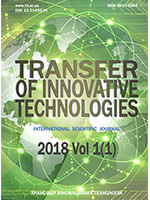Efficiency of use of high-strength concrete in reinforced concrete structures
DOI:
https://doi.org/10.31493/tit1811.0301Keywords:
High strength concrete, plasticity, strength, crack resistance, deflection, modulus of elasticityAbstract
The analysis of the use of modern high-strength concrete in world practice is carried out. The advantages and disadvantages of highstrength concrete have been analyzed. The existing examples of the implementation of high-strength concrete in the world and their types and areas of application are considered. The prospects for using high-strength concrete in the construction industry of Ukraine are determined.Use of qualitative materials for the construction of supporting structures of high-rise building, and the construction of bridges, tunnels and other highly responsible buildings and structures. High-strength concrete with high durability, waterproof and gas tightness, corrosion resistance due to its homogeneous structure is efficient and promising for maintenance of all needs. In this work, samples of cubes, prisms, beams were developed and tested experimentally to determine and consider the efficiency of using high strength concrete in bending elements. In this article there are presented experimental results of tests, data on the selection of the effective composition of concrete mixture, and provided experimental samples with characteristic fractures. On the samples of the cubes that were presented, it can be seen the principles of destruction − the class C20 with normal destruction, and in the classes C60 and C80 there is a fragile nature of destruction. Also, the results of tests of prism fractures of classes C20, C60 and C80 were presented, where examples of fracture are also provided and elastic moduli of the samples were determined. The combined table showed cubic and prism strength, which shows the effectiveness of applying high-strength concrete in comparison with traditional concrete, since in concrete increase the compressive strength and the relative tensile strength, density, decreases the porosity and the structure is generally improved. The results of experimental studies of durability and crack resistance of reinforced concrete beams made of high-strength concrete are presented and compared with beams of ordinary concrete.References
Nehdi R. M., Mindness S. & Aitcin P.C., 1998. Rheology of high performance concrete: Effect of ultrafine particles. Cement and Concrete Research, 28(5), 687-697.
Berg O.J., Shcherbakov E.N., Pisanko G.N. 1971. High-strength concrete. Moskow: Stroyizdat, 196.
Kutsyk O.V., Zhuravsky O.D., 2016. Analysis of the use of high-strength concrete in modern construction. Urban Planning and Territorial Planning: Science. Tech. collection. Kyiv, KNUCA, Iss.61, 444-449.
Kutsik О., 2017. Efficiency of using highstrength concrete. Build-master-class-2017, III International conference 2017, 181-182.
Kutsyk O.V., Zhuravsky O.D., 2017. Strength and crack resistance of bent elements of highstrength concrete. Building Constructions. Theory and Practice, Iss.1, 199-204
Abbas R., Abo-El-Enein S.A. & Ezzat E.S., 2010. Properties and durability of metakaolin blended cements: Mortar and concrete. Materiales De Construccion, 60, 33-49.
Wild S., Khatib J.M. & Jones A., 1996. Relative strength, pozzolanic activity and cement hydration in superplasticised metakaolin concrete. Cement and Concrete Research, 26(10), 1537-1544.
Badogiannis E. & Tsivilis S., 2009. Exploitation of poor Greek kaolins: Durability of metakaolin concrete. Cement & Concrete Composites, 31(2), 128-133.
Tiwari A.K. & Bandyopadhyay P., 2003. High performance concrete with Indian metakaolin. In International symposium on innovative world of concrete, 19-21 September. Pune: Indian Concrete Institute.
Basu P.C., 2003. High performance concrete. In Proceedings INAE national seminar on engineered building materials and their performance, 426-450.
Kuprienko P., Lapovska S., Kuprienko N., 2017. Nanomodified natural aluminum silicates in technology treatment of industrial waste and the production of building materials. Underwater Technologies, Iss.5, 74-83.
Basu P.C., Mavinkurve S., Bhattacharjee K. N., Deshpande, Y. & Basu, S., 2000. High reactivity metakaolin: A supplementary cementitious material. In Proceedings ICIAsian conference on ecstasy in concrete, 20-22 Nov, Bangalore, India, 237-436.
Boddy A., Hooton R.D., & Gruber K.A., 2001. Long-term testing of the chloridepenetration resistance of concrete containing high-reactivity metakaolin. Cement and Concrete Research, 31, 759-765.
Dvorkin L., Bezusyak A., Lushnikova N., & Ribakov Y., 2012. Using mathematical modelling for design of self compacting high strength concrete with metakaolin admixture. Construction and Building Materials, 37, 851– 864.
Guneyisi E., Gesoglu M., & Mermerdas K., 2008. Improving strength, drying shrinkage, and pore structure of concrete using metakaolin. Materials and Structures, 41, 937-949.
Haque M.N., & Kayali O., 1998. Properties of high strength concrete using a fine fly ash. Cement and Concrete Research, 28(10), 14451452.
Poon C.S., Lam L., Kou S.C., Wong Y.L. & Wong R., 2001. Rate of pozzolanic reaction of metakaolin in high-performance cement pastes. Cement and Concrete Research, 31(9), 13011306.
Mehta P.K., & Monteiro P.J., 1999. Concrete: microstructure, properties, and materials. Delhi, India: Indian Concrete Institute.
Downloads
Published
How to Cite
Issue
Section
License
Copyright (c) 2020 Transfer of Innovative Technologies

This work is licensed under a Creative Commons Attribution-NonCommercial-NoDerivatives 4.0 International License.
Our journal abides by the CREATIVE COMMONS copyright rights and permissions for open access journals.
Authors, who are published in this journal, agree to the following conditions:
1. The authors reserve the right to authorship of the work and pass the first publication right of this work to the journal under the terms of a Creative Commons Attribution License, which allows others to freely distribute the published research with the obligatory reference to the authors of the original work and the first publication of the work in this journal.
2. The authors have the right to conclude separate supplement agreements that relate to non-exclusive work distribution in the form in which it has been published by the journal (for example, to upload the work to the online storage of the journal or publish it as part of a monograph), provided that the reference to the first publication of the work in this journal is included.




